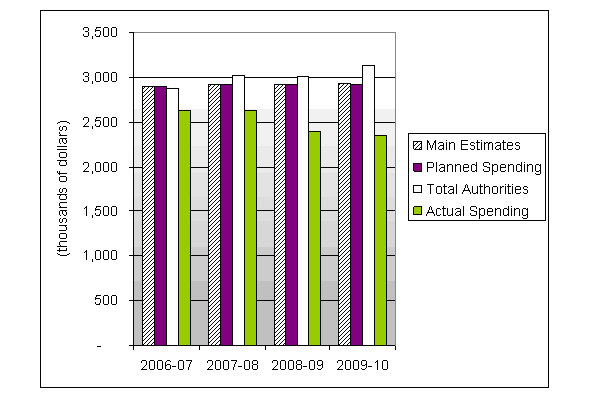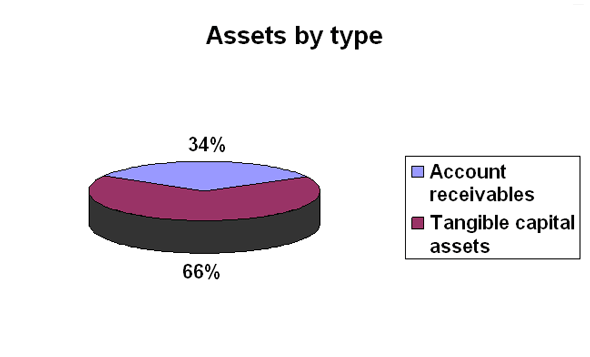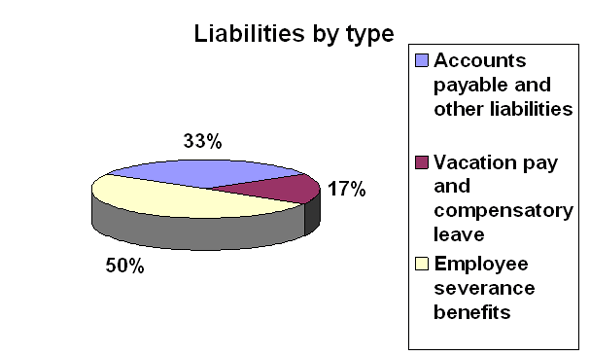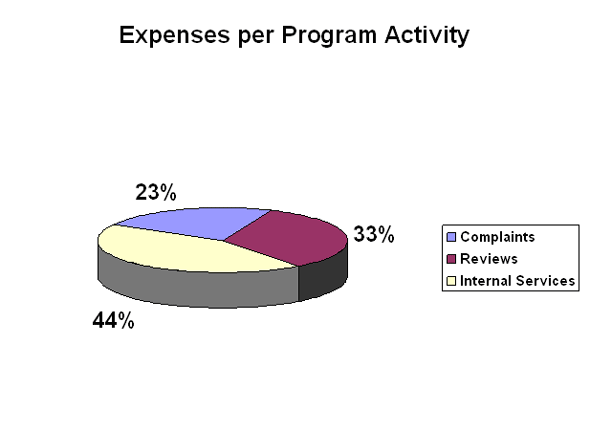ARCHIVED - Security Intelligence Review Committee - Report
 This page has been archived.
This page has been archived.
Archived Content
Information identified as archived on the Web is for reference, research or recordkeeping purposes. It has not been altered or updated after the date of archiving. Web pages that are archived on the Web are not subject to the Government of Canada Web Standards. As per the Communications Policy of the Government of Canada, you can request alternate formats on the "Contact Us" page.
2009-10
Departmental Performance Report
Security Intelligence Review Committee
The original version was signed by
The Right Honourable Stephen Harper
Prime Minister of Canada
Table of Contents
Section I: Departmental Overview
- Raison d’être
- Responsibilities
- Program Activity Architecture (PAA)
- Performance Summary
- Contribution of Priorities to Strategic Outcome(s)
- Risk Analysis
- Expenditure Profile
- Variance explanation for Spending Trend graph
- Voted and Statutory Items
Section II: Analysis of Program Activities by Strategic Outcome
Section III: Supplementary Information
- Financial Highlights
- Financial Highlights Charts/Graphs
- Financial Statements
- List of Supplementary Information Tables
- Other Items of Interest
Chair’s Message

I am pleased to introduce the Departmental Performance Report of the Security Intelligence Review Committee (SIRC or the Committee) for the fiscal year 2009-2010.
This past year has been one in which both public and media interest in security intelligence matters has remained high. This is due in part to decisions by the courts and to ongoing commissions of inquiry which have had a direct impact on the Canadian Security Intelligence Service (CSIS or the Service). The Committee recognizes the complexity of today’s threat environment and the challenges faced by CSIS; in turn, these reinforce SIRC’s continuing and critical role of ensuring CSIS’s accountability.
As an experienced Committee Member and SIRC’s newly appointed Chair, I take pride in the Committee’s commitment to provide expert, independent assurance to the Parliament of Canada and, through it, to Canadians that the Service is acting effectively, appropriately and lawfully in the performance of its duties and functions.
Our reviews and complaint reports provide an important means to reassure Canadians that CSIS investigates threats to national security in a manner that respects Canada’s core democratic values. The Canadian Security Intelligence Service Act (CSIS Act) continues to guide SIRC’s work in assessing CSIS’s performance against the mandate and authorities conferred upon it by Parliament in 1984. The Committee embraces the belief that balancing collective public safety with individual rights is a hallmark of Canada’s democratic values and aspirations. It is a theme that I am confident will continue to guide SIRC’s work in the future.
Honourable Arthur T. Porter, P.C., M.D.
Chair
Section I: Departmental Overview
Raison d’être
The Canadian Security Intelligence Service (CSIS) performs its duties and functions in accordance with the law, policy and Ministerial direction.
Responsibilities
The Security Intelligence Review Committee (SIRC or the Committee) is a small, independent review body that reports to Parliament on the operations of the Canadian Security Intelligence Service (CSIS or the Service). It was established at the same time that CSIS was created in 1984, and derives its powers from the same legislation, the CSIS Act.
In order to fulfill its purpose, SIRC has three Program Activities. The first is to conduct in-depth reviews of CSIS activities in order to ensure that CSIS carries out its duties and functions appropriately, effectively and in accordance with the CSIS Act and the various policy instruments that flow from it, and with direction from the Minister. The second is to investigate complaints by any person about any action of the Service. The third Program Activity encompasses the internal services required to support the functioning of the organization.
Program Activity Architecture (PAA)
The chart below illustrates SIRC’s framework of program activities, which roll up and contribute to progress toward the organization’s Strategic Outcome.

Performance Summary
2009–10 Financial Resources (thousands of dollars)
| Planned Spending | Total Authorities | Actual Spending |
|---|---|---|
| 2,919 | 3,132 | 2,355 |
2009–10 Human Resources (FTEs)
| Planned | Actual | Difference |
|---|---|---|
| 21 | 14 | 7 |
| Strategic Outcome: The Canadian Security Intelligence Service (CSIS) performs its duties and functions in accordance with the law, policy and Ministerial direction. | ||
|---|---|---|
| Performance Indicators | Targets | 2009–10 Performance |
| Number of reviews/complaint investigations that reported CSIS activities were in compliance with the CSIS Act, Ministerial Direction and operational policy. | No major incidents of non-compliance by CSIS. | SIRC review findings and the results of complaint investigations found no major incidents of non-compliance by CSIS. |
(thousands of dollars)
| Program Activity | 2008–09 Actual Spending |
2009–10[1] | Alignment to Government of Canada Outcome | |||
|---|---|---|---|---|---|---|
| Main Estimates |
Planned Spending |
Total Authorities |
Actual Spending |
|||
| Reviews | 1,494 | 1,584 | 1,577 | 1,621 | 836 | SIRC provides assurance that the Service is acting within law, policy and Ministerial direction which contributes to such government of Canada outcomes as a safe and secure Canada and a safe and secure world through international cooperation. These, in turn, promote public trust in democratic institutions and in turn strengthen the interaction between those institutions and Canadian citizens. |
| Complaints | 905 | 569 | 569 | 644 | 577 | |
| Internal Services | Note 1 | 773 | 773 | 867 | 942 | |
| Total | 2,399 | 2,926 | 2,919 | 3,132 | 2,355 | |
| Full Time Equivalent | 16 | 21 | 21 | 21 | 14 | |
Contribution of Priorities to Strategic Outcome(s)
| Operational Priorities | Type | Status | Linkages to Strategic Outcome |
|---|---|---|---|
| Continuous improvement for reviews and complaints | Ongoing |
Successfully met
|
The Canadian Security Intelligence Service (CSIS) performs its duties and functions in accordance to the law, policy and Ministerial directions. |
| Management Priorities | Type | Status | Linkages to Strategic Outcome(s) |
|---|---|---|---|
| Improved corporate management | Ongoing |
Successfully met
|
The Canadian Security Intelligence Service (CSIS) performs its duties and functions in accordance to the law, policy and Ministerial directions. |
Risk Analysis
The security intelligence community has undergone several legal, policy and program changes in response to the evolving threat environment. SIRC continues to monitor discussion and debate about potential and ongoing Government initiatives that may impact upon the nature and scope of SIRC's reviews and complaints investigations.
Given its small size, SIRC has struggled in the past with central agency reporting requirements. Because SIRC lacks dedicated functional specialists who would be solely responsible for financial, security, informatics and human resource management, SIRC has had to rely on a combination of external contractors and internal staff to carry out these functions. In 2009-10, SIRC has seen a welcome decline in the reporting requirements made on the organization by central agencies.
Expenditure Profile

Variance explanation for Spending Trend graph
SIRC’s actual spending for 2009-10 was $2,355 thousands which is similar to the 2008-09 actual spending. Spending remains lower than anticipated as a result of reduced operational costs which were primarily due to a temporary increase in the vacancy rate for the research group.
Voted and Statutory Items
(thousands of dollars)
| Vote # or Statutory Item (S) | Truncated Vote or Statutory Wording | 2007–08 Actual Spending |
2008–09 Actual Spending |
2009–10 Main Estimates |
2009–10 Actual Spending |
|---|---|---|---|---|---|
| 1 | Program expenditures 1 | 2,373 | 2,215 | 2,649 | 2,123 |
| (S) | Contributions to employee benefit plans | 253 | 184 | 277 | 232 |
| Total | 2,626 | 2,399 | 2,926 | 2,355 | |
Due to rounding, figures may not add to the totals shown
1Please refer to the spending trends graph for more details on departmental spending trends.
[1] Commencing in the 2009-10 Estimates cycle, the resources for Program Activity: Internal Services are displayed separately from other program activities; they are no longer distributed among the remaining program activities, as was the case in previous Main Estimates. This has affected the comparability of spending and FTE information by Program Activity between fiscal years.
Section II: Analysis of Program Activities by Strategic Outcome
Strategic Outcome
SIRC has only one strategic outcome: that CSIS performs its duties and functions in accordance with the law, policy and Ministerial direction.
SIRC is uniquely situated to provide context to the broader public debates about the nature and scope of the threat environment, and how these are addressed. Although SIRC does not promote any particular viewpoint or policy perspective, the reviews and complaint reports provide important snapshots of CSIS’s work offering a careful assessment as to whether the Service addresses these threats appropriately and effectively and in a manner that respects its powers and authorities. This outcome is important to Canadians, because it helps to protect their fundamental rights and freedoms. SIRC serves as a cornerstone in assuring the democratic accountability of one of the Government’s most powerful security organizations.
The following section describes SIRC’s program activities, including how they contributed to SIRC’s performance at the strategic outcome level.
The three program activities that will be discussed are:
- In-depth reviews of CSIS activities;
- Investigations of complaints; and,
- Internal Services.
Program Activity by Strategic Outcome
Reviews
The purpose of the Review Program is to conduct reviews of CSIS activities to ensure that CSIS performs its duties and functions appropriately and effectively, and in accordance with legislation, policy and Ministerial Direction. Through a comprehensive and multifaceted program of research, SIRC staff examine various aspects of CSIS’s operations and activities to prepare a retrospective analysis for the Committee’s approval.
SIRC’s Review Program is designed to address a broad range of CSIS’s duties and functions. This approach allows the Committee to manage the inherent risk of being able to review only a small percentage of CSIS activities in any single year. In selecting reviews, SIRC takes into consideration domestic and world events; issues, priorities and concerns identified by Canadians and Parliament; past reviews; matters of interest identified in complaints investigations; and existing and emerging CSIS activities. Over the course of several years, SIRC is able to examine a significant number of CSIS’s investigations and functions. The Committee must always be prepared to adjust the review program to address unforeseen events.
| Program Activity: Reviews | |||||
|---|---|---|---|---|---|
| 2009–10 Financial Resources ($ denomination) | 2009–10 Human Resources (FTEs) | ||||
| Planned Spending |
Total Authorities |
Actual Spending |
Planned | Actual | Difference |
| 1,577 | 1,621 | 836 | 12.5 | 7 | 5.5 |
| Expected Results |
Performance Indicators |
Targets | Performance Status |
Performance Summary |
|---|---|---|---|---|
| Improvement of CSIS's performance based on the findings and recommendations that SIRC makes in its reviews. | Percentage of SIRC’s review recommendations accepted by CSIS | 70% of SIRC’s review recommendations accepted by CSIS | Met all | CSIS has accepted a majority of SIRC’s recommendations |
| Frequency that key elements of CSIS activities and operations are reviewed | Key elements of CSIS activities and operations are reviewed at least once every five years | Met all | SIRC visited two regional offices and a CSIS foreign station and examined multiple functional programs of the Service. | |
| Number of reviews completed as per SIRC's annual Research Plan | 100% of reviews completed per SIRC’s annual Research Plan | Met all | SIRC completed 6 reviews which represented 100% of SIRC’s 2009-10 Research Plan |
SIRC’s reviews assess CSIS’s performance and may include findings and non-binding recommendations. These reviews are submitted to the Director of CSIS, the Inspector General CSIS and, in special circumstances, to the Minister of Public Safety. A declassified summary of each review is included in SIRC’s Annual Report. The objective is to provide Parliament and Canadians with “snapshots” of past CSIS operations that, over time, provide a comprehensive picture of CSIS’s performance.
The Review Program has three sub-activities: the production of SIRC’s Annual Report and communications material, outreach and liaison.
SIRC’s Annual Report to Parliament is the main communications vehicle for informing Canadians about its work. To the best of its ability and within the legal constraints governing national security and privacy, every review undertaken and every complaint investigated, is summarized in SIRC’s Annual Report. In accordance with Section 53 of the CSIS Act, SIRC submits this report to the Minister of Public Safety for tabling in Parliament within 15 sitting days of the House. In addition to producing an Annual Report, SIRC also undertakes a modest communications program. Communications materials produced for the Committee, including speeches, news releases and backgrounders are posted on SIRC’s website.
Outreach refers to events external to government, such as presentations to seminars and conferences by Committee Members and staff.
Liaison refers to maintaining constructive relationships with bodies such as Parliamentary Committees. Over the years SIRC has appeared in front of the House Standing Committee on Public Safety and National Security and the Senate Standing Committee on National Security and Defence.
Performance Analysis
SIRC has developed several performance measurements for reviews. One measure is whether the research plan approved by the Committee at the beginning of the fiscal year is completed in its entirety. In fiscal year 2009-2010, SIRC undertook and completed six reviews which represent 100% of the research plan.
In addition, SIRC Committee Members and senior staff visited two CSIS regional offices, as planned in the 2009-2010 Report on Plans and Priorities. This provided the Committee with an opportunity to explore the day-to-day work of investigators in the field and to learn about the priorities and challenges of regional offices. Committee Members met with senior CSIS staff and received briefings on regional issues. The Committee also took the occasion to communicate its focus and concerns to CSIS. In addition, the Committee also reviewed one of CSIS’s foreign stations. The primary focus of SIRC’s review of these stations is to monitor the Service’s operations at station and its information-sharing in that context with foreign and domestic agencies.
Other performance measures include follow-up with CSIS to identify whether they have acted on the recommendations contained in previous SIRC reviews; the number and scope of reviews relative to SIRC’s available resources; how frequently different aspects of CSIS operations are reviewed; and feedback on the quality of reviews from those who receive them.
As noted above, the Review Program has three sub-activities: the production of SIRC’s Annual Report and communications material, outreach and liaison.
SIRC’s Annual Report to Parliament is the main communications vehicle for informing Canadians about its work. In accordance with s. 53 of the CSIS Act, the Report was submitted to the Minister of Public Safety.
Outreach refers to events external to government, such as presentations to seminars and conferences by Committee Members and staff. Examples would be the Executive Director’s lecture at Carleton University in November 2009 and the Committee and Executive Director’s attendance at the International Intelligence Review Agencies Conference in March 2010 in Sydney, Australia.
Liaison refers to maintaining constructive relationships with bodies such as Parliamentary Committees. No appearances were requested of the Committee during 2009-10.
Lessons Learned
SIRC’s review function continues to adapt to the rapidly changing environment in which security intelligence operates. SIRC continuously examines its review methods and sources to ensure that the Committee fully understands the diverse range of CSIS activities and operations.
Complaints
The purpose of the Complaints Program is to investigate complaints made against CSIS by individuals or groups. SIRC acts as an independent, quasi-judicial administrative tribunal and conducts investigations in relation to:
- complaints “with respect to any act or thing done by the Service” as described in the CSIS Act;
- complaints about denials of security clearances to federal government employees and contractors;
- referrals from the Canadian Human Rights Commission in cases where the complaint relates to the security of Canada; and
- Minister of Public Safety’s reports concerning the Citizenship Act.
Once a written complaint is received, SIRC conducts a preliminary review. Where a complaint does not meet certain statutory requirements, SIRC declines jurisdiction and the complaint is not investigated. If SIRC determines that it has jurisdiction, it is usually investigated through a quasi-judicial hearing presided over by one or more Committee Members, assisted by staff. In investigating complaints, SIRC has all of the powers of a superior court, and has access to all information in the possession of CSIS, except for Cabinet confidences.
Parties have the right to be represented by counsel and to make representations to the Committee. Pre-hearings may be conducted to establish and agree on procedures with the parties and/or their counsel. SIRC’s legal team provides legal advice on procedural and substantive matters, and will also cross-examine CSIS and other witnesses when, for national security reasons, evidence must be heard in the absence of a party.
At the completion of a hearing, the complainant is advised in writing of the Committee’s decisions, once any information with national security implications is removed. Depending on the type of complaint, SIRC also sends a report with findings and recommendations to the Minister of Public Safety, the Director of CSIS and – in cases involving the denial of a security clearance – the Deputy Minister of the federal department involved. Summaries of these reports, edited to protect national security and the privacy of the complainants, are also included in SIRC’s Annual Report to Parliament.
| Program Activity: Complaints | ||||||||
|---|---|---|---|---|---|---|---|---|
| 2009–10 Financial Resources ($ denomination) | 2009–10 Human Resources (FTEs) | |||||||
| Planned Spending |
Total Authorities |
Actual Spending |
Planned | Actual | Difference | |||
| 569 | 644 | 577 | 6.5 | 5 | 1.5 | |||
| Expected Results |
Performance Indicators |
Targets | Performance Status |
Performance Summary |
||||
|---|---|---|---|---|---|---|---|---|
| Parties before SIRC receive a fair and timely resolution of their complaint | Percentage of SIRC complaint decisions upheld by the Federal Court on judicial review | 100% of complaint decisions upheld | Mostly Met | One complaint decision was set aside by the Federal Court in a judicial review application. | ||||
| Percentage of complaints where SIRC's decision on jurisdiction is made within 60 working days of receiving a formal and complete written complaint | 85% of all jurisdictional decisions | Somewhat Met | SIRC strives to meet the established performance indicator; however, certain elements of the process are beyond the organization’s control. As such, the indicators for the next review period have been adjusted in the 2009-2010 RPP to account for this reality. | |||||
| Percentage of complaints where SIRC's report is issued within two years of accepting jurisdiction | 85% of all complaint reports | Not Met | SIRC strives to meet the established performance indicator; however, certain elements of the process are beyond the organization’s control. As such, the indicators for the next review period have been adjusted in the 2009-2010 RPP to account for this reality. | |||||
Performance Analysis
A number of factors will impact the Committee’s ability to fulfill its mandate and the time required to resolve complaint investigations. These include the volume and complexity of complaints received and investigated, the quantity of documents to be reviewed, the number of hearings, the availability of participants, staffing changes and the appointment of new members. In 2009-2010, the Committee issued two complaint reports; in addition, one of its decisions on a matter of procedure was brought before the Federal Court.
Lessons Learned
The Committee continues to strive to ensure that its investigations of complaints are conducted in a fair, thorough and timely manner. A number of complaints before the Committee during the period under review raised a complex jurisdictional issue which will be addressed by the Committee in the next review period. In addition, the Committee has initiated consultations with organizations exercising similar functions with a view to amending its Rules of Procedure.
Internal Services
Internal Services are groups of services, activities and resources that are administered to support the needs of the two programs and corporate obligations of SIRC.
| Program Activity: Internal services1 | |||||
|---|---|---|---|---|---|
| 2009–10 Financial Resources ($ denomination) | 2009–10 Human Resources (FTEs) | ||||
| Planned Spending |
Total Authorities |
Actual Spending |
Planned | Actual | Difference |
| 773 | 867 | 942 | 2 | 2 | 0 |
1 Commencing in the 2009-10 Estimates cycle, the resources for the Internal Services program activity are displayed separately from other program activities; they are no longer distributed among the remaining program activities, as was the case in previous Main Estimates. This has affected the comparability of spending and FTE information by Program Activity between fiscal years.
This activity captures all of the costs associated with monthly meetings attended by Committee Members, including their per diems, travel and accommodation costs. Corporate Direction and Internal Services also includes ongoing refinement to SIRC's website, as well as the general informatics support required to maintain computing systems. Through a Memorandum of Understanding, the Privy Council Office provides some administrative and financial services to SIRC. In addition, financial and human resource management services not provided by the Privy Council Office are funded through this activity.
Section III: Supplementary Information
Financial Highlights
Condensed Statement of Financial Position
| (in dollars) | |||
|---|---|---|---|
| At March 31, 2010 | % Change | 2010 | 2009 |
| Assets | |||
| 105% | 140,339 | 68,565 | |
| Total Assets | 105% | 140,339 | 68,565 |
| Liabilities | |||
| Liabilities | (36%) | 585,607 | 912,720 |
| Equity of Canada | 47% | (445,268) | (844,155) |
| Total Liabilities and Equity of Canada | 105% | 140,339 | 68,565 |
Condensed Statement of Financial Operations
| ($ denomination) | |||
|---|---|---|---|
| For the year ended March 31, 2010 | % Change | 2010 | 2009 |
| Expenses | 9% | 2,575,733 | 2,826,193 |
| Net Cost Of Operations | 9% | 2,575,733 | 2,826,193 |
Total net cost of operations was $2,575,733 at the end of 2009-2010, a decrease of $250,460. The decrease is due to a reduction of salary related expenses such as employee benefits plan, allowances for severance pay and vacation pay.
Financial Highlights Charts/Graphs

Total assets were $140,339 at the end of 2009-2010, an increase of $71,774 (105%) over the previous years, total asset of $68,565 mainly due to an increase of the account receivables related to salaries and the acquisition of new capital assets. Tangible capital assets represent the largest portion of their assets with $92,751 or 66% of all assets.

Total liabilities were $585,607 at the end of 2009-2010 representing a decrease of $327,113 (36%) over the previous year’s total liabilities of $912,720. The decrease was mainly due to a significant reduction of year end accrued expenses related to salaries.

Total expenses for the Security Intelligence Review Committee were $2,575,733 for fiscal year 2009-2010 compared to $2,826,193 for fiscal year 2008-2009.
$848,403 (33%) was spent under the Review Program Activity, $600,520 (23%) was spent under the Complaints Program Activity and $1,126,810 (44%) was spent under the Internal Services.
As per the above pie chart, the internal services’ expenses are being presented as a separate activity in the financial statements based on the Treasury Board Secretariat’s new reporting requirements. In previous years, internal services expenses were distributed between program activities. SIRC has three key program activities related to its strategic outcome.
The increase in the level of expenses for the program activity “Complaints” from fiscal year 2008-09 ($529,103) to 2009-10 ($600,520) is mainly due to a staff shortage in 2008-09 and the hiring of senior level lawyer in fiscal year 2009-10 to fill vacant positions.
The decrease in the level of expenses for the program activity “Reviews” from fiscal year 2008-09 ($931,320) to 2009-10 ($848,403) is mainly due to less salary expenses related to staffing shortages.
The third program activity, Internal Services, captures all of the costs associated with monthly meetings attended by Committee Members, including per diems, travel and accommodation costs. SIRC is a small organization, highly centralized where many costs normally assumed by line managers (e.g. all informatics and technical services, furniture and equipment, supplies, printing and graphics, messenger services, telecommunications) are covered by corporate services and are not re-allocated to the other two program activities.
Financial Statements
Further information regarding SIRC’s financial statements is available online at: www.sirc-csars.gc.ca/opbapb/fstefi-eng.html.
List of Supplementary Information Tables
All electronic supplementary information tables found in the 2009–10 Departmental Performance Report can be found on the Treasury Board of Canada Secretariat’s website at: http://www.tbs-sct.gc.ca/dpr-rmr/2009-2010/info/info-eng.asp.
Other Items of Interest
Contact Information
Security Intelligence Review Committee
P.O. Box 2430 Station “D”
Ottawa, Ontario
K1P 5W5
Telephone: (613) 990-8441
Facsimile: (613) 990-5230
Internet: www.sirc-csars.gc.ca
E-Mail: info@sirc-csars.gc.ca
Legislation Administered
Canadian Security Intelligence Service Act